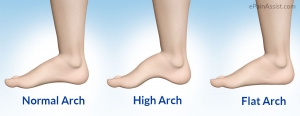Flat feet are commonly seen in the population. High foot arches are rare but should be picked up by a podiatrist or physiotherapist.
High arches are not as commonly seen in the foot as flat feet. However, both high arches and flat feet can cause problems. Flat feet occur when there is not enough arch in the foot and high arches occur when there is too much of an arch. In both situations, the foot is not being held in neutral and this causes abnormal load through the foot and lower limb and often to pain and inflammation. There is also the hidden complication of rotation of the foot caused by these conditions that can again lead to problems with pain. The basic problem with high arched feet is that they are too rigid and do not produce enough shock absorption on landing because of their inability of the arch to flatten which is the normal function of the foot during certain stages of gait. With flat feet it is the opposite scenario. The foot has too little support and therefore arches are usually placed in the shoe to support the foot. High arches have too much support and are too rigid. Due to the fact that these type of feet are not commonly seen not a lot of research has been done into this specific area. You really need to find a shoe that offers little stability but lots of shock absorption. This may be in the form of gel, air or DMX. It should have a midsole flare, which helps with cushioning. The shoe should also have a lack of torsion control. If you take a shoe by the toe and heel and twist in the majority of shoes this movement is minimal and that is what most people need, stability in a shoe. But those with high arches need a shoe with minimal support but lots of shock absorption. Shop for a shoe to suit your needs, where they are able to cater for people with high arches and flat feet.
As well as adjusting your shoe, look at the surface that you place sport on. The harder the surface the more shock your foot has to take and the more pain and inflamed it will become. Grass and sprung wooden floors are good playing surfaces because of their ability to absorb stress. Another factor is weight. If you weight more than you should then this will greatly increase the stress placed through your feet. Aim to stay at your optimum weight or just below to ensure your feet endure your life journey. Physiotherapists assess feet and the biomechanics of the weight-bearing style. Orthotics can be useful to address biomechanic factors although this may only be a temporary measure.
Finally, if all this doesn’t help you may need to see a podiatrist or orthotist. They are the best people to be able to assess high arch issues. They may try to cushion your arch not for support but for absorption of shock and in order to maintain the foot in the neutral normal position for optimum performance. Flat feet, seen much more commonly are treated regularly through physiotherapy.

